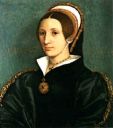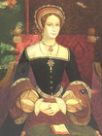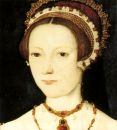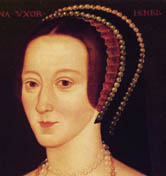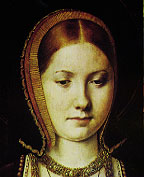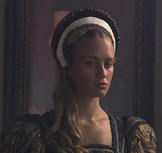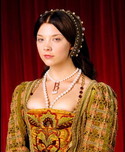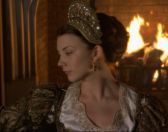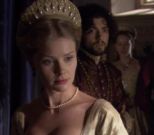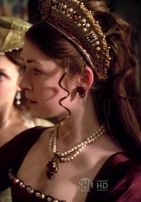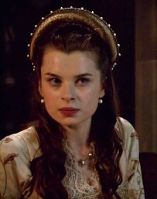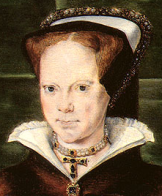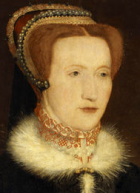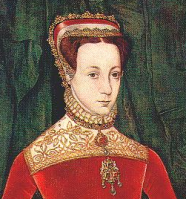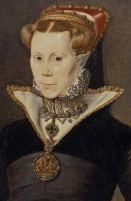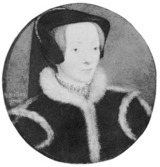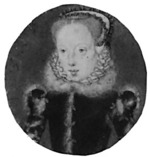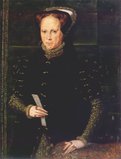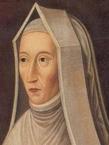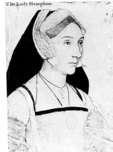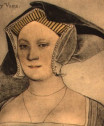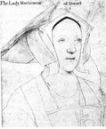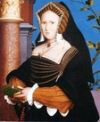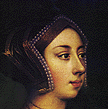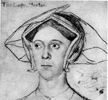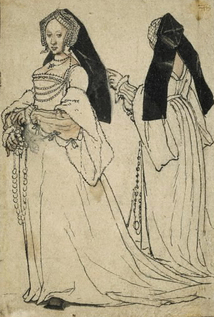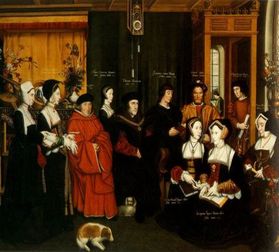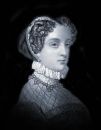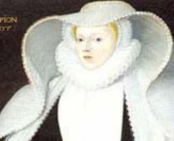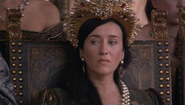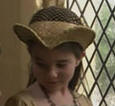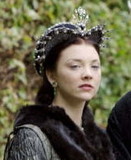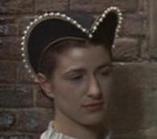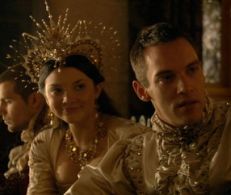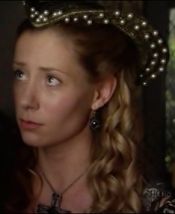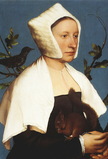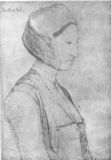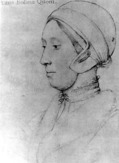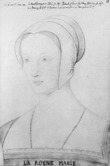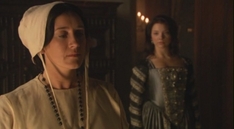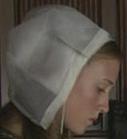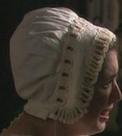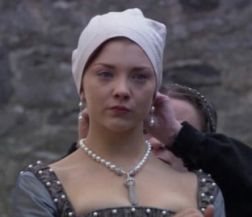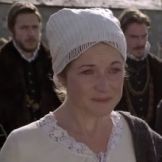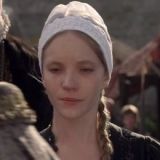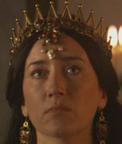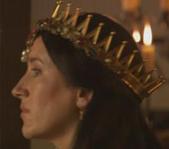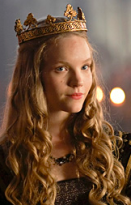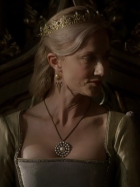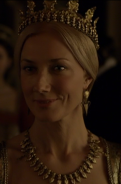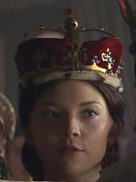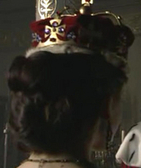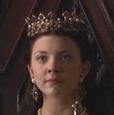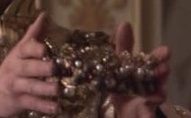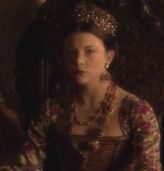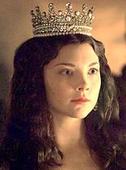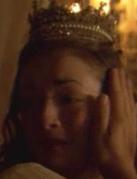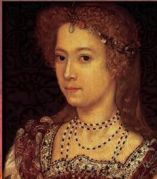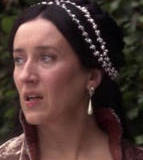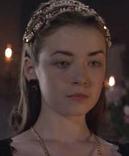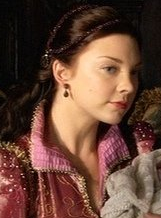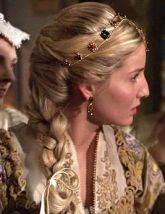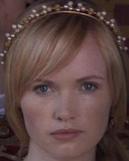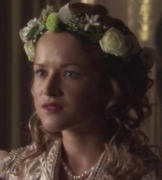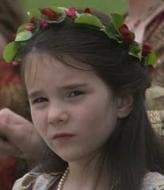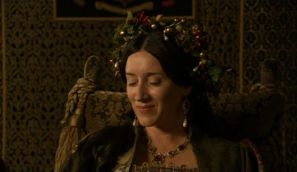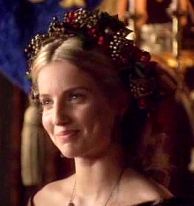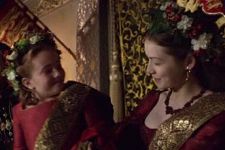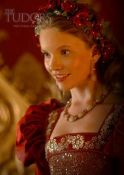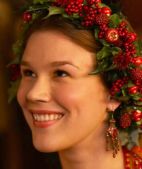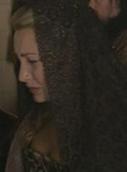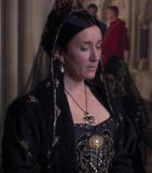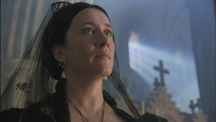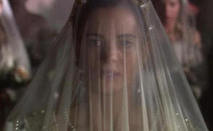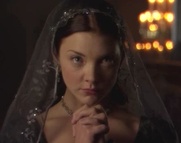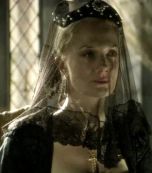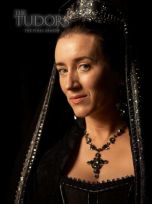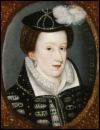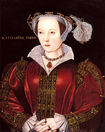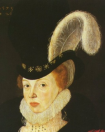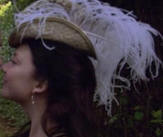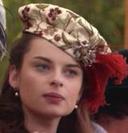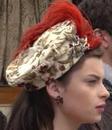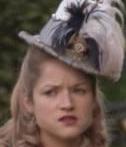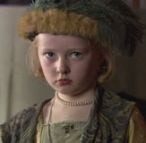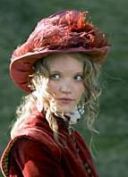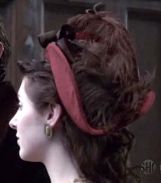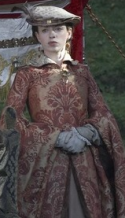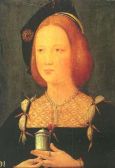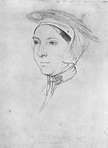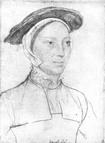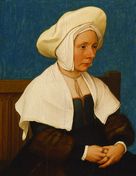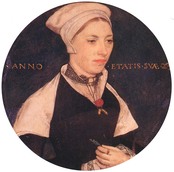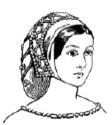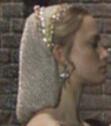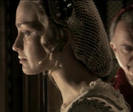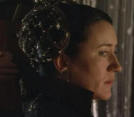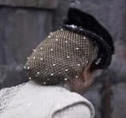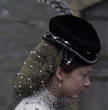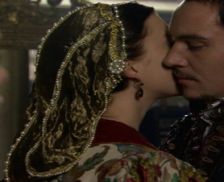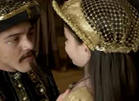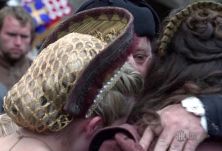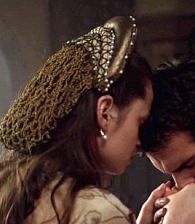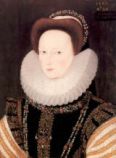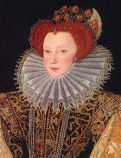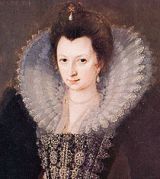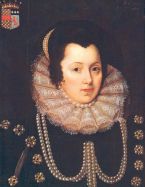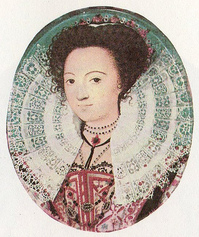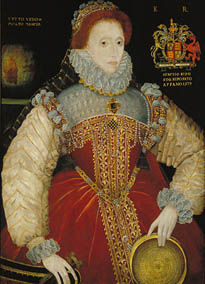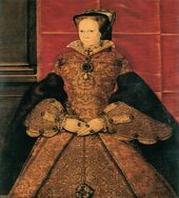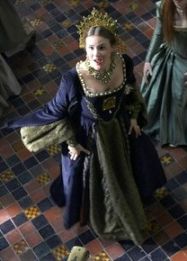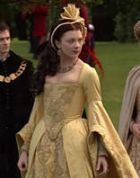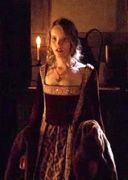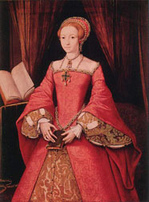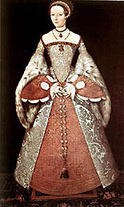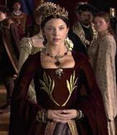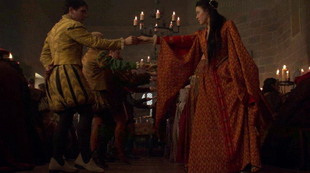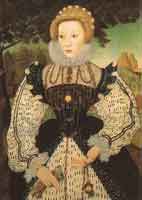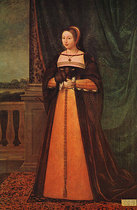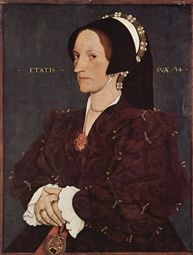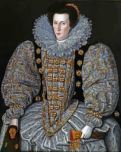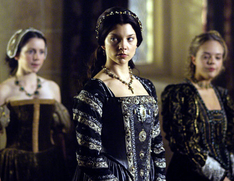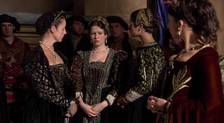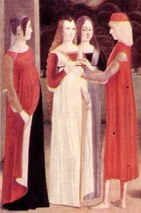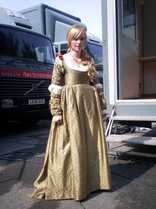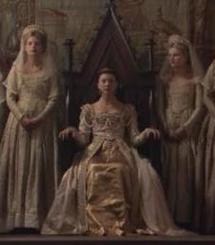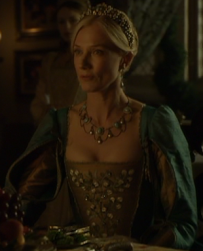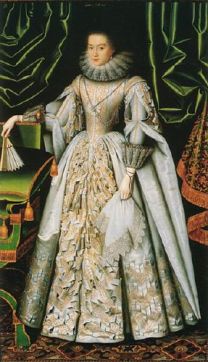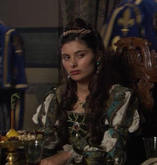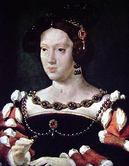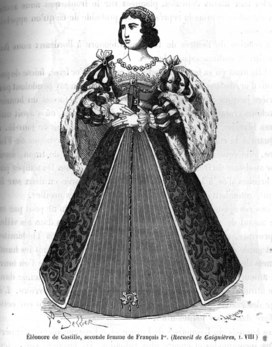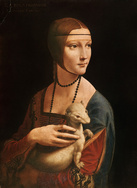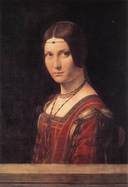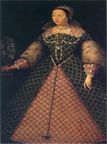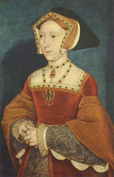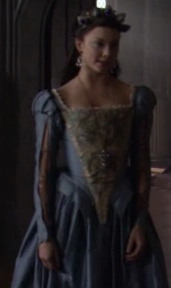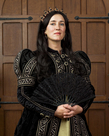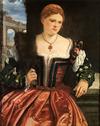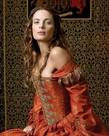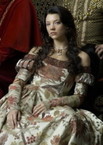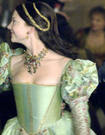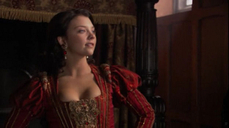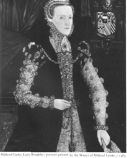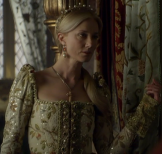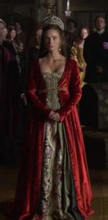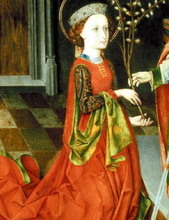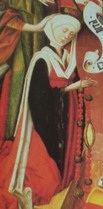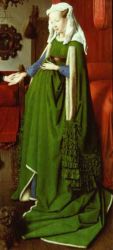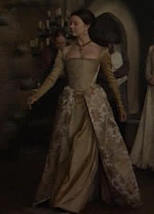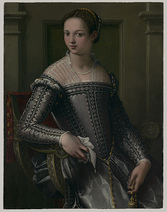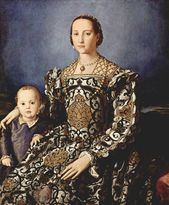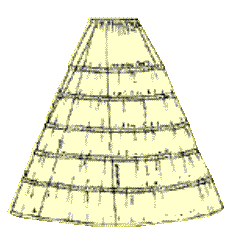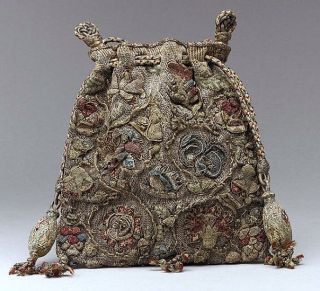The Tudors Costumes : Women's Dress
Jump to navigation
Jump to search
| TUDOR STYLE: Women's Dress |
| Women's clothing gave them a triangular shape unlike the men's square shape. Their corsets were tight-fitting, while their kirtles and gowns were full. Their head-dress consisted of a coif that fitted closely around the face, to which was attached the cornet. |
| Please note: The historical pictures on this page are only shown as the inspiration for 'The Tudors' costumes. They are not meant to show accuracy of historical costumes & the series. Read The Tudors Costumes page before this one to learn more about the costume designer's premise for her designs. This is a FAN site, if copyright issues occur - you have several options : 1. Remove them yourself posting a note to say why it was removed. (A free registration with Wet Paint is required in order to make edits) This is a wiki and everyone has the option to edit. 2. Contact the moderators (click "members" above and you will see a list of mods.) See The Tudors Wiki Guide 3. You can add the credit to your site (it may improve traffic to your own site & perhaps you can teach the fans something?) |
| Head-dresses (see also: Hoods & Headdresses on The Tudors) The French Hood - a half moon or crescent style band or brim sloping away from the face. The edges of the french hood were often adorned with pearls or glass jewels called bilaments and a veil called a cornet covered the back of the hair. Examples : Basically, the first one to design and use it, was Anne of Bretagne. She introduced the style and made it popular in the French Court when she became queen of France, marrying for second time the heir to the throne, this time his brother in law, Louis XII
| On the left is the French hood worn by courtier Anne Boleyn at the time when she met Henry, c.1527-28. The round hood style originated in France with Anne of Bretagne (to the left of this section, see French hood images), who first wore this French style. It was Anne Boleyn who made this hood popular in the Tudor Court before and after her reign. By the time of her death, the French hood was a fashion that was too popular to be eradicated, even in the times of Queen Elizabeth I. Mary I, Henry's first daughter also wore the French hood, in a modified English version. On the right side above, is a portrait of Queen Katherine of Aragon at the time she became a widow after her husband Arthur's death, c.1502. The French hood here is in its initial stages. Although round and oval, it still lacks the semi-halo-oval type we came to know thanks to Anne Boleyn. | ||||||||||||
| The Flat Hood - a hybrid of the French hood This had its influence on the french hoods, and of the hybrid of French and gable hood (as show below to your right in the black and white picture the last two from left to right). Its origin was with Mary I when she became Queen. She made this hood popular during her times, and (as it is seen in the left picture below) she wore this style throughout her reign as Queen.
Left, Mary I of Queen of England, right is Bess of Hardwick, the middle row is of Mary Fitzalan, Duchess of Norfolk and either Lady Jane Grey or Mary I. Left: Cecily Heron, daughter of the late St. Thomas More, wears a hybrid between gable-french hood, very popular during the late 1520s which also looks like a sort of french-gable hybrid diadem-hood. Right: Anne Cressacre More is also wearing this hybrid diadem hood, drawn slightly backwards. | Catherine Willoughby (called Catherine Brandon in the series - wife of Charles Brandon) is wearing a hybrid between flat and coif hood which covers a great part of her head. This model was the first basis model Mary Tudor could have based upon for her creation of the flat hood she later wore during her reign as Queen. 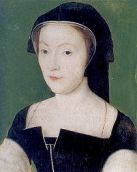 Catherine Grey, Countess of Hertford, was imprisoned by royal orders of Queen Elizabeth (died after her release at Cockfield Hall, Suffolk at the age of 27), she is wearing here the flat hood that was once popular during Mary I reign. Mary I It was during Mary's reign that trumpet-style bell sleeves with extensive fur became popular with many noble ladies. Another popular trend during her reign was the flat hood, very similar to the once popular french hood, but flat on the top and more drawn back, not covering much of the hair or head in front. | ||||||||||||
Unique to England was the Gable Hood, a wired headdress shaped like the gable of a house. In the 1500s gable headdress had long embroidered lappets framing the face and a loose veil behind. Later the gable hood would be worn over several layers that completely concealed the hair, and the lappets and veil would be pinned up in a variety of ways. Steeple-Shaped English Hood: A early version of the English Gable Hood, worn in the mid to late 1400s and early 1500s. The English-style Gable hood which was popular with more conservative ladies | This drawing shows the front & back of the gable hood (The women wearing the combination of gable and French low-cut but visible hood, are in this picture: Cecily Heron, and Anne More. The other family members are using the hybrid that emerged on the late 1520s, a flat sort of diadem hood, which combined the styles of the French and gable hood. This was painted c.1527-28) A new style emerged, (the first picture of the entire More Family shown above) however; it was a combination between early french hood styles and English gable hoods, it did not cover much of the head, and the style was very similar to the french hood. This style was popular amongst the young crowd at the end of 1520s. This style can be seen in the famous painting by Holbein the younger, of Thomas More's family. | ||||||||||||
| The Atifet - similar to the French Hood but with a heart-shaped crescent. This headdress style, it should be noted, became popular in the French Courts and in Scotland with Mary, Queen of Scots and the Isles. Mary wore it most of the time, as she was brought up in the French Court, since she was shipped to France to meet her future husband, with whom she was not married for long. The atifet had a heart-shaped french hood style and mostly originated in France. It was also used at the English Court among the royals and nobles from the 1550s to the end of 16th Century. | The Coif - commonly referred to as the 'biggin' and worn by all children, poorer Tudor-era women and nuns. The material of the coif was plain white linen and consisted of a close-fitting cap tied under the chin. Coifs were often worn by rich Tudor-era women to keep their hair in place under more elaborate hats. | ||||||||||||
 Crowns & Coronets: the royal head-dress of sovereignty, worn by a monarch or consort, usually circular in form, has an open centre and is characterized in most cases by vertical ornaments (for example fleurs-de-lis) projecting upward from the rim and by two or four arches topped at the intersection by some symbolic ornament (e.g. cross). There are several types, depending upon the occasion for their use: coronation crown, used only at coronation, state crown, worn at other state occasions; personal crown; wedding or nuptial crown, and so on. (See also The Tudors Ladies Tiaras page) Crowns & Coronets: the royal head-dress of sovereignty, worn by a monarch or consort, usually circular in form, has an open centre and is characterized in most cases by vertical ornaments (for example fleurs-de-lis) projecting upward from the rim and by two or four arches topped at the intersection by some symbolic ornament (e.g. cross). There are several types, depending upon the occasion for their use: coronation crown, used only at coronation, state crown, worn at other state occasions; personal crown; wedding or nuptial crown, and so on. (See also The Tudors Ladies Tiaras page) | Anne wears the coronet of a marquess during her investure ceremony. Different style coronets signified rank of peerage. The coronet styles in use by the English peerage today has been fixed since the reign of the Stuarts. Usually these coronets were worn by the men who held the title in their own right or by inheritance, Anne was the first English woman to be ennobled in her own right on September 1, 1532. (See more peer coronets on the Tudor List of Court Titles & Offices Page & The Tudors Royal Crowns) |
<a href="../" target="_self">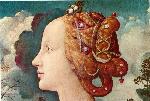 </a> </a>Diadems: an ornamented band, made of metal, jewels or pearls, worn around the brow or head sometimes as a badge of sovereignty. 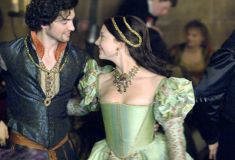 <img align="bottom" alt="The Tudors Costumes : Women's Dress - The Tudors Wiki" height="141" src="http://image.wikifoundry.com/image/1/GW4W0ANo2X5omgecxQRhRQ5333/GW104H141" title="The Tudors Costumes : Women's Dress - The Tudors Wiki" width="104"/> 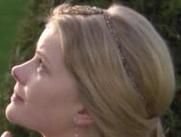 | 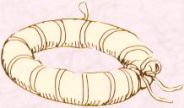 First-time brides wore their hair loose, in token of virginity, and a wreath or chaplet of orange blossoms was traditional. A jeweled wreath with "enamalled orange blossoms" was sometimes worn. First-time brides wore their hair loose, in token of virginity, and a wreath or chaplet of orange blossoms was traditional. A jeweled wreath with "enamalled orange blossoms" was sometimes worn. |
| Veils: | 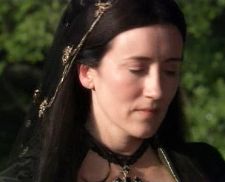 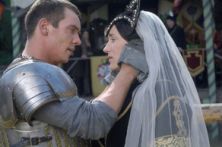 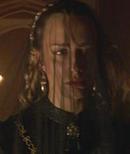 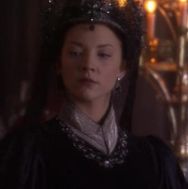 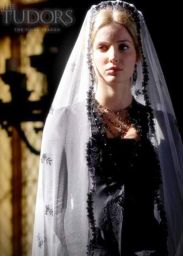 |
| Women's Hats with Feathers: More examples of women's hats: | Bag Snoods: Popular during the first half of the century, snoods were mostly worn in England and France with the French hood. Sometimes the snoods or snood bag would be attached or plastered on the back of the French hood. In some places like Spain and Italy, snoods would be worn as a simple net without any hat on, although in Italy very colorful snoods and decorations would be use as those in England and France. The snood was a net that contained hair, much like a modern snood, the difference was that back in the 16th century these snoods would be (as previously mentioned) attached to the back of the head, french hood, etc. It would contain hair very tightly on some occasions, although it is known that some snoods allowed some hair to break free like one of the following examples: (They were very much used in Spain in the first half of the Century and very popular, Isabelle of Castille liked to wear them herself, only without the french hood. Soon after her death though, many started to used them, attaching the snood to the back of the french hood.) |
Neck Ruffs: Neck ruffs, especially on women, were very popular during the Elizabethan era and during the reign of James I (who was also James VI of Scotland). 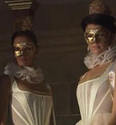  Anne Boleyn as played by Natalie Dormer 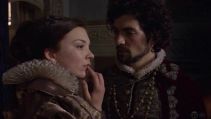  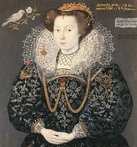 <a class="external" href="http://flickr.com/photos/romanyway_designs/218465221/" rel="nofollow" target="_blank" title="1595 English lady"> <a class="external" href="http://flickr.com/photos/romanyway_designs/218465221/" rel="nofollow" target="_blank" title="1595 English lady">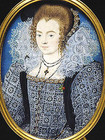 </a> </a>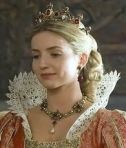 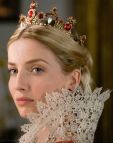 Jane Seymour as played by Annabelle Wallis 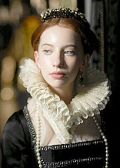 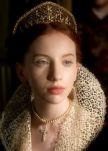 Princess Elizabeth Tudor as played by Laoise Murray | Sometimes the ruff would go completely around the neck. Other Elizabethan designs split the ruff in two on the shoulders of the dress and opened up wide at the neck. * All colours, materials& trims of clothing were strictly controlled by Tudor Sumptuary Laws : for a basic chart of these laws, click here |
| Sleeves on women's dresses "Trumpet" or "Bell" Sleeves: 16th-century women's fashion is known for its large and use of fur making wide sleeves, most known today are the "trumpet" sleeves, which would be so wide that it would give them the style of the trumpet, they were mostly associated because of the wide effect fur on the sleeves would give, then the "bell" sleeves would have a similar effect only these sleeves would be associated with those with the same effect but without fur, therefore their name, these sleeves like all the earlier sleeves from the start of the century were made of fur and they were very popular in England and France. Here are some examples: SECOND ROW: Left: Princess Elizabeth Tudor , in the famous Windsor Portrait of her at age 13. Look at the detail of the sleeves. They don't have fur, but have a sort of "trumpet" effect. (Above right) Natalie Dormer, is wearing hanging sleeves, which create the effect of a mixture between "bell" and "trumpet" sleeves. These sleeves are incorrect for the period depicted in The Tudors, and her dress is missing other decoration on the sleeves and neckline which a lady of the nobility would usually have. The lack of decoration makes her look as if she is from the middle class, and Anne Boleyn would have hardly missed wearing these decorations in real life. Catherine Parr (above right), sixth queen of Henry VIII's reign, is wearing sleeves like those of Mary I in the portrait pictured above. Hanging Sleeves: | Semi-puffed Sleeves: Elizabethan sleeves varied from the high-puffed, "trumpet" fur sleeves or just "trumpet" and "bell" sleeves to semi-puffed sleeves from the top that were more attached to the body as they went to the bottom of the arm, there was no more sleeve-hanging as was worn in the first half of the Sixteenth Century. Compare & contrast Margaret Wyatt, Lady Lee Lady in waiting to Anne Boleyn 1540 (From Left to Right, Katherine of Aragon; Elizabeth Hastings, Countess of Worcester; and Mary, Queen of Scots) Slashed sleeves at the elbow and shoulder of a late 15th-century Florentine gown, (top row middle) the lady-in-waiting gown is a perfect example of the style, while Anne Boleyn's coronation gown lacks the slashed sleeves but has the same style with a high waisted bodice and wide skirt which perfectly conceals her pregnancy |
| Slashed Sleeves: Slashed sleeves were very popular during the first half of the century, that is from 1500-1550, especially in countries like Spain, Italy and Portugal. In Germany, France and England, slashed sleeves became increasingly popular by the end of the 1520s and continued their popularity during the end of the century in Elizabethan Period. Elizabethan gown with neck ruff. The slashing may be seen along the full length of the sleeves, SECOND ROW: Queen Claude (above, left) wears a combination of French 16th-century sleeves and Italian renaissance clothing. but also on the top of the bodice. 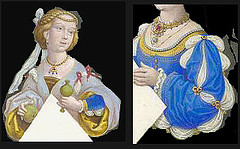 .  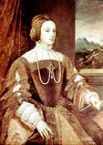 Some slashing only extended to the last half of the sleeve, or to a second pair of sleeves. Others, like the ones of Isabel of Portugal (First row in the cell above this top row of pictures, shown on the right side) extend only to the first pair or similarly to start from top and end at the middle and vice versa. Some Slashing began at the end of Sleeves, that is the second pair of sleeves that was some-what hidden after the first set of sleeves, that is the hanging or "Trumpet" Sleeves. Like the ones show above you can see the details of the slashing sleeves at the end of the sleeves, they were a second pair of sleeves, the Jane Seymour Portrait (First Portrait in the Bottom row below the first picture of Katherine Parr) show slashing at the end of the second pair of sleeves, the slashing on these sleeves is at the bottom as well as the other first half of the Sixteenth-Century Portraits, like the Windsor Portrait of Princess Elizabeth (second Portrait from left to right in the second row) at age thirteen shows the slashing also on the center of the second pair of sleeves, on the top of these, like the first picture above this where Katherine Parr (Top Row) also wears this fashion, much like Catherine de Medici at the time she was Queen of France, only her slashings seem more concealed (right, in second row). | Other Examples of 16th-Century Sleeves: Comments: Showtime's original series,"The Tudors", has become a national and worldwide hit due to their originality in portraying historical figures as human beings rather than just staunchly protestant or catholics, and humanizing them, unlike other shows who de-humanize them and put them in black and white perspective; but also the show has a great score of fans for the great variety of Costuming. The Costume Designer has taken great liberty in de-constructing the Costumes, most of the costumes you see here are for comparing how original they are with the time period, if this was a show for the Elizabethan Period they would probably score a big 90 from scale of 1-100. But since the show is from the Tudor Period, the show has mixed Elizabethan fashion with Italian and French Renaissance Fashion and Clothing. By looking at the pictures you can compare how much your favorite show is being loyal to the time period and contrast the differences of the Fashion mix the creators or better say the Costume Designer has innovated with her great new and fresh designs. |
| Corsets: There were a great variety of corsets during the beginning and middle of the 16th century to the beginning of the 17th Century. 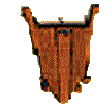 It has been found that some women who could not get accustomed to wearing these types of corsets would have fractured ribs. Some women would even have trouble breathing, and it's no wonder why. 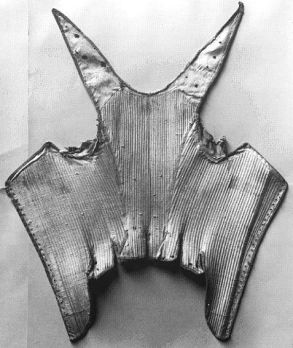 The ‘effigy corset’ of Elizabeth I. Worn by her effigy in Westminster Abbey for centuries and may have been worn by her. | 16th-century, late Elizabethan Corsets |
| <a class="external" href="http://www.realtech.co.za/realwiki.php?title=Image:Pedro_Garc%C3%ADa_de_Benabarre_St_John_Retable_Detail.jpg" rel="nofollow" target="_blank" title="Probably the earliest depiction of the Spanish verdugada. Pedro GarcÃa de Benabarre, Salome from the St John Retable, Catalonia, 1470-80."> The Spanish farthingale was a hoop skirt. The name comes from Spanish verdugo 'green wood', because the dying stems of Giant Reed are rigid. Spanish farthingales were an essential element of Tudor fashion in England, and remained into the early 17th century. </a> | 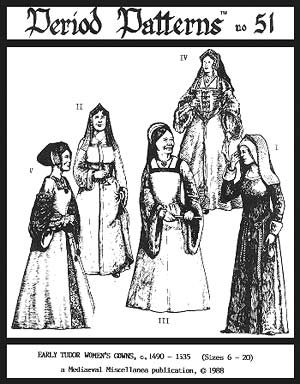 |
| Purses: A purse is essentially a pouch, and pouches have been used by man (and woman, of course) for as long as human memories have been recorded. Men, however, used to be the ones who’d give women their purses. Wedding purses were a traditional gift from groom to bride through the 15th century. The bags typically were elaborately embroidered with an illustration of a love story. An elaborately embroidered English purse dating to the last quarter of the sixteenth century. Made of coloured silks with gold thread on linen. | 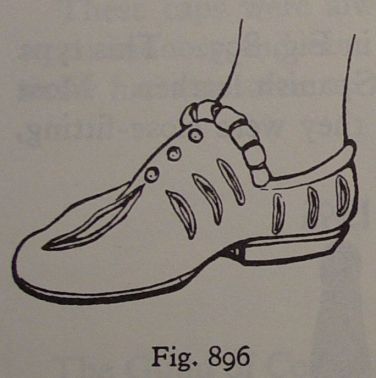 Shoes: Unfortunately women's shoes were usually hidden by their long flowing dresses so it's not easy to know what they looked like. But it is thought that both men and women wore flat low-cut, square-toed slippers. The toes, rolled back and often slashed to reveal a colored lining, became enormously wide and eventually had to be limited by law. |
A further note on Ladies shoes In the Tudor period, shoes varied according to the fashion and requirement. The first Tudor shoes had a blunt toe, with the style becoming more pointed towards the late 1590's. Soles got thicker with the uppers becoming more tailored. To start off with, shoes were flat with high heels becoming very popular during Elizabeth's reign raising 10cm off the ground. Early shoes slipped straight on the foot, buckles and laces were introduced during the Elizabethan era. Early heels consisted of several layers of stacked leather. but when the heel became high, the waist of the shoe (the place between the heel and ball) was strained. Thus this caused the waist to collapse making the shoe unwearable. To solve this problem, a second piece of leather was (shank originally invented by the Romans) was placed on the waist to support the height of the heel. Rich women wore very light shoes of silk or embroidered materials. The soles were of thin leather lined with satin. Dressing in a court gown could take up to sixty minutes as some gowns were very grand, it was usually the shoes, stockings and earrings that went on on first. The working class however, wore rough leather boots and shoes. Women's shoes were of thin leather, pattens were good for protecting the shoes in foul weather. Pattens date from the 13th century and were popular in Europe, known in France also as galoshes, they were worn until the 19th century. |






